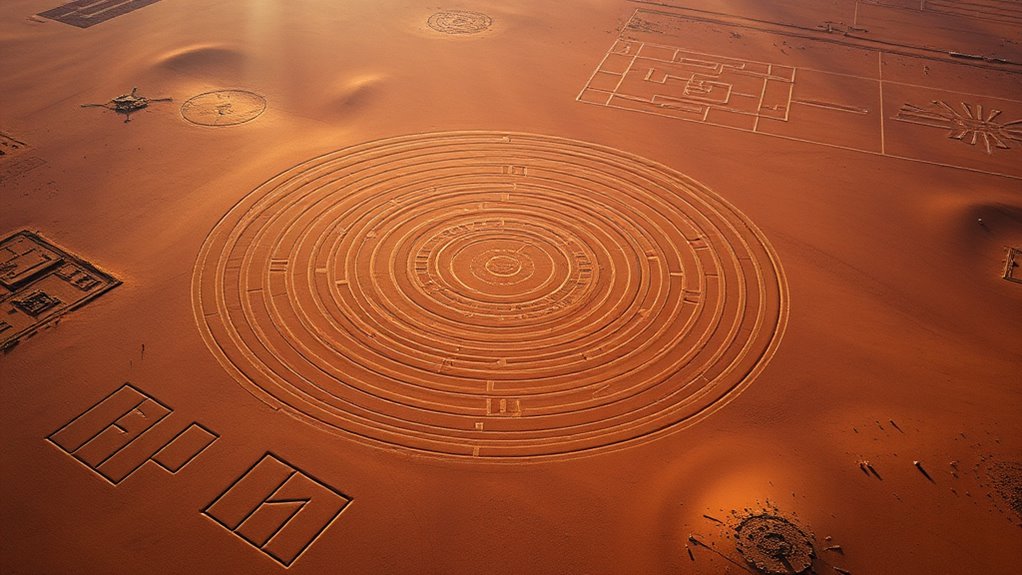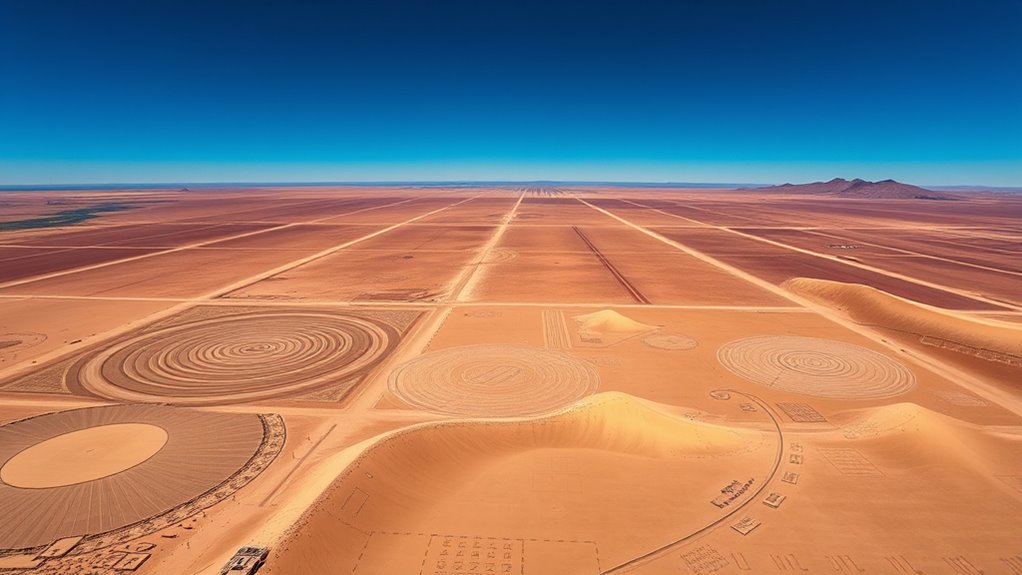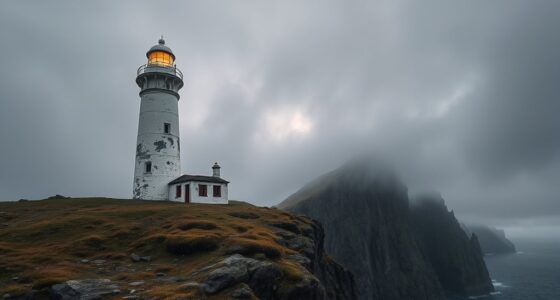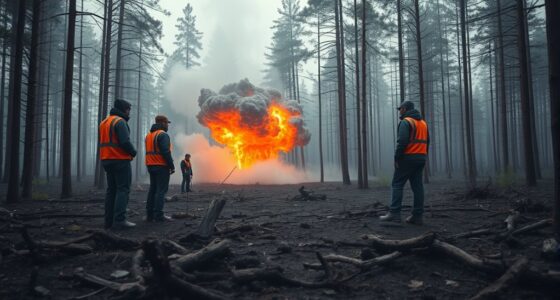Latest drone surveys of the Nazca Lines show these massive geoglyphs are carefully designed with precise geometric patterns. You’ll see how the creators used advanced planning to align the lines with specific stars and horizons, suggesting intentionality and purpose. The detailed aerial images reveal they weren’t random but part of a sophisticated system, possibly linked to astronomical or ritual functions. Keep exploring to discover more about how these ancient symbols continue to amaze modern science.
Key Takeaways
- Drone surveys provide high-resolution images revealing precise geometric alignments of the Nazca Lines.
- Recent aerial data confirms the intentional design and planning behind the geoglyphs’ layouts.
- Advanced drone imaging helps distinguish deliberate carvings from natural desert features.
- Survey findings suggest the geoglyphs serve astronomical or ritual purposes based on their geometric arrangements.
- Modern drone technology uncovers the sophisticated understanding of geometry and landscape manipulation by ancient creators.

Have you ever wondered how ancient civilizations managed to create such vast and intricate designs on the desert floor? The Nazca Lines, a series of enormous ancient geoglyphs etched into the arid plains of southern Peru, continue to captivate researchers and visitors alike. Recent drone surveys have revolutionized our understanding of these mysterious figures, revealing that their layout isn’t random but rather the result of purposeful geometry. Using aerial archaeology techniques, experts now see how each line, figure, and pattern aligns with precise measurements and celestial events, hinting at a complex system of symbols and meanings.
Thanks to high-resolution drone imagery, you can now observe the Nazca Lines from perspectives that were once impossible to achieve. These aerial perspectives uncover how the geoglyphs are carefully planned and executed, with some lines stretching over hundreds of meters. The survey data highlights that the ancient creators deliberately designed the figures with geometric precision, aligning them with the horizon or specific stars. This suggests the lines had a ritual or astronomical purpose, possibly serving as markers for astronomical events or seasonal calendars. The newfound clarity provided by drones allows researchers to trace the construction methods, revealing that the lines were carefully planned long before they were etched into the desert surface.
High-resolution drone imagery reveals the Nazca Lines’ precise, deliberate design and their possible astronomical and ritual significance.
Aerial archaeology has played a pivotal role in decoding the purpose of these geoglyphs. By capturing detailed images from above, archaeologists can analyze the layout with greater accuracy, identifying subtle alignments and patterns that are invisible from the ground. This method also helps distinguish between natural formations and deliberately carved lines, ensuring the integrity of the interpretations. It’s now understood that the Nazca Lines are not just random designs but an interconnected system of symbols, possibly linked to water deities or celestial phenomena, reflecting the culture’s cosmological beliefs. Additionally, the integration of automation technologies in archaeological surveys has enhanced the ability to analyze large datasets and improve understanding of site layouts.
With drone technology, you gain a new appreciation for the sophistication of the ancient Nazca people. The precise geometry seen today confirms that these geoglyphs weren’t created haphazardly but were carefully calculated and executed. Aerial archaeology is uncovering the logic behind their placement, revealing a society with advanced understanding of geometry, astronomy, and landscape manipulation. These latest drone surveys continue to deepen our appreciation of how ancient civilizations used their environment and craftsmanship to communicate complex ideas, leaving behind a legacy that still puzzles and inspires us.
Frequently Asked Questions
How Are the Nazca Lines Best Preserved Today?
You can best preserve the Nazca Lines today through ancient preservation methods complemented by modern technology. Protecting the site involves restricting access and controlling pollution, while drone surveys help monitor their condition without physical contact. These advanced techniques enable preservation efforts to be precise and effective, ensuring that future generations can continue to appreciate this incredible cultural heritage. Combining traditional approaches with modern technology offers the most sustainable way to safeguard these remarkable geoglyphs.
What Materials Were Used to Create the Nazca Lines?
Imagine ancient construction as a dance of earth and sky—this is what you see in the Nazca Lines. Material analysis reveals they used simple materials like stones, gravel, and reddish-brown iron oxide to create striking contrasts. You can envision the careful removal of top layers to reveal lighter soil beneath, forming precise geometric shapes and figures. These materials, chosen for their durability, preserve the lines for centuries, telling stories carved into the desert floor.
How Long Did It Take to Complete the Nazca Lines?
You might wonder how long it took to complete the Nazca Lines, considering the ancient construction and labor efforts involved. It’s believed that these enormous geoglyphs were created over several centuries, starting around 500 BCE to 500 CE. The labor efforts required coordinated planning and teamwork, with construction likely spanning generations. Their precise design indicates a significant investment of time and skill by the ancient Nazca people.
Are There Any Recent Discoveries Near the Nazca Lines?
You might be curious if recent discoveries near the Nazca Lines shed light on ancient agricultural practices or mythical interpretations. Recent drone surveys have uncovered new geoglyphs and artifacts, suggesting the area once held significant ritual or agricultural importance. These findings deepen our understanding of how the Nazca people integrated their environment into their spiritual and practical lives, revealing more about their culture and beliefs beyond just the famous lines.
Can Drone Technology Help Uncover Hidden Nazca Geoglyphs?
You might wonder if drone technology can uncover hidden geoglyphs. Absolutely, drones equipped with high-resolution cameras can scan large areas quickly, revealing subtle features that satellite mapping might miss. They also assist with archaeological dating by providing detailed imagery, helping you analyze the age and context of discoveries. This technology enhances your ability to explore and understand ancient sites, revealing secrets long hidden beneath the landscape.
Conclusion
These new drone surveys show that the Nazca Lines are more than just mysterious shapes—they’re carefully planned and purposeful. As the evidence stacks up, it’s clear that we’re not just chasing shadows but uncovering a hidden story. The lines serve as a reminder that sometimes, you have to look beneath the surface to see the bigger picture. With each discovery, it becomes obvious that the past is enthusiastic to share its secrets—if you’re willing to dig a little deeper.









